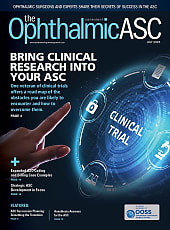Editor’s note: Introducing the Trials in Focus column, where we talk with trial investigators about trials under way. In our first installment, Tony Realini, MD, chair of the research team for the COAST study, describes the goals and status of the trial.
The glaucoma treatment paradigm is in flux. The recent report of 6-year outcomes from the landmark Laser in Glaucoma and Ocular Hypertension Trial (LiGHT) revealed that patients with newly diagnosed open-angle glaucoma (OAG) or ocular hypertension (OHTN) demonstrate less visual field progression and lower rates of glaucoma and cataract surgery when treated with primary selective laser trabeculoplasty (SLT) compared with more traditional topical medical therapy.
A paradigm in which the use of topical medical therapy is delayed for as long as possible — or perhaps even avoided entirely — is a valuable goal. Topical medical therapy has been the first-line standard of care for more than 150 years, and although multiple studies have demonstrated the effectiveness of medical therapy in preventing the development and progression of glaucoma, topical medical therapy is not without limitations. The most important is nonadherence. Numerous studies have documented nonadherence rates in the range of 30% to 80%, which can lead to disease progression. Side effects are also a common problem. In addition to transient instillational discomfort and other mild or minor issues, long-term complications include a roughly 50% risk of developing ocular surface disease with chronic topical glaucoma therapy.
Selective laser trabeculoplasty overcomes both limitations of medical therapy. A paradigm shift to an SLT approach to glaucoma is long overdue and should be welcome news to both providers and patients. However, SLT has an important limitation as well: its effect wears off over time, and although it can be safely and effectively repeated, many eyes eventually stop responding to SLT and require topical therapy. In LiGHT, roughly half of eyes required 1 or more retreatments during the 6-year follow-up period, with approximately 70% of eyes receiving SLT as primary therapy remaining medication free through 6 years. Conversely, 30% of eyes treated with primary SLT repeated as needed became nonresponsive to subsequent SLT and ultimately required topical medical therapy within 6 years.1
Is there a different way of performing SLT that will extend medication-free survival longer than the way we currently perform SLT? If so, more patients could avoid the need for topical medical therapy over their lifetime. The COAST study — Clarifying the Optimal Application of SLT Therapy — is a pair of prospective, randomized trials designed to answer 2 clinical questions: (1) can we turn down the laser energy and get the same outcomes that we do with standard-energy SLT? and (2) will a regimen of low-energy SLT, repeated annually to maintain disease control, provide greater long-term medication-free survival than the current approach of standard-energy SLT repeated when its effect wears off? COAST hypothesizes that maintaining trabecular meshwork (TM) health and function with annual low-energy booster retreatments will extend medication-free survival more effectively than trying to rescue the impaired TM with as-needed repeat treatment when its effect wears off.
Eligible COAST participants have OHTN or mild-to-moderate primary OAG and are treatment-naïve or only minimally treated (no more than 6 months on eye drops, which are washed out at study entry). At study entry, they are randomly assigned to undergo SLT either at standard energy (starting at 0.8 mJ and titrating to fine champagne bubbles) or to low energy SLT (0.4 mJ), with treatment consisting of 100 treatment spots through the full 360° of the TM in both eyes. The primary endpoint of this first randomized trial is a comparison of the proportions of eyes achieving target intraocular pressure (IOP) at month 12 without the need for repeat SLT. At month 12, participants are re-randomized to receive low-energy SLT, repeated annually irrespective of IOP, to maintain TM health and function, or to SLT at initially assigned energy repeated only when its effect wears off and IOP rises above target IOP (which is essentially rescue therapy for the TM). The primary endpoint of this trial is a comparison of the 4-year medication-free survival rates between groups.
Just as LiGHT showed us that primary SLT is better than medications for our patients with newly diagnosed glaucoma, we hope COAST will show that annual low-energy SLT is better than standard energy SLT repeated as needed for long-term avoidance of medical therapy. COAST is supported by the National Eye Institute/National Institutes of Health. I serve as the study chair, with logistical support provided by the Epidemiology Data Center at the University of Pittsburgh. The study is being conducted at 30 centers in 3 countries and is actively enrolling participants. A list of COAST study sites, and the study’s eligibility criteria, can be found at www.coasttrial.org for anyone who would like to refer a patient to a COAST site. We have established a referring partners program that provides recognition for sites referring patients who are subsequently enrolled in COAST; information about this program can also be found on the study’s website. GP
Reference
- Gazzard G, Konstantakopoulou E, Garway-Heath D, et al. Laser in Glaucoma and Ocular Hypertension (LiGHT) trial: six-year results of primary selective laser trabeculoplasty versus eye drops for the treatment of glaucoma and ocular hypertension. Ophthalmology. 2023;130(2):139-151. doi:10.1016/j.ophtha.2022.09.009









